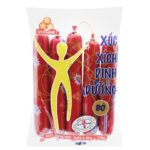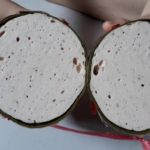According to Associate Professor Dr. Nguyen Duy Thinh, a former faculty member at Hanoi University of Technology, potassium alum was previously used in food technology as it helped preserve food for extended periods, preventing spoilage and enhancing elasticity. It was commonly added to baked goods like bánh đúc (rice cake) to make them firmer, and to rice noodles like bánh cuốn to improve their texture and make them chewier.
However, over time, experts recognized that potassium alum is an extremely toxic chemical that can have detrimental long-term health effects and may even lead to cognitive decline. As a result, Vietnam has prohibited its use in food production and processing, regardless of the quantity or method of application. Nevertheless, many food businesses still illegally add potassium alum as a food additive to enhance the texture of their products.

How to detect the presence of potassium alum in pork rolls and sausages is a concern for many consumers. (Illustrative image)
Potassium alum does not affect the color of pork rolls, making it challenging to identify solely through visual inspection. One way to determine if a pork roll contains potassium alum is by taste. Pure pork rolls have a distinctive flavor, and after swallowing, the taste lingers in the back of the throat. When chewing, a clean-tasting pork roll should feel soft, moist, and slightly sticky, without any dry or hard sensations. If the pork roll has an overpowering fragrance, it may be an indication of excessive additives. Additionally, if the pork roll feels abnormally dry, tough, or unusually smooth when bitten into, it likely contains potassium alum.
By observing the pork roll, you may also notice some irregularities. A simple test is to press your finger into the meat; if it feels soft and yields to the touch, it is normal. However, if it feels exceptionally firm and does not indent, it may be an indication of the presence of potassium alum.
Another method is to cut the pork roll or sausage into slices and try to stretch them by pulling the two ends apart. If the meat stretches easily without tearing or resists tearing, it likely contains potassium alum. With a little attention to detail, one can identify these treated pork rolls through sensory indicators such as color and elasticity.
Moreover, pure pork rolls or sausages that do not contain potassium alum or other additives have a characteristic appearance when sliced. You will notice air pockets or holes in the meat. If the slices appear unusually smooth and uniform, it suggests the presence of additives. Authentic pork rolls without potassium alum should feel slightly moist to the touch, with a pale pinkish-white color. In contrast, the surface of those containing potassium alum may appear slightly rough.
According to experts, another way to detect the presence of potassium alum is to observe the meat while cutting it. Clean pork rolls tend to stick to the knife, making it challenging to slice smoothly. In contrast, pork rolls containing potassium alum will slide off the knife more easily.
Additionally, there is a test using turmeric paper. This method only provides a qualitative rather than quantitative analysis. Soak a piece of paper in fresh turmeric water, dry it, and then press it against the surface of the pork roll. If, after a minute, the paper turns from yellow to reddish-orange, it indicates the presence of potassium alum.
These are some effective ways to detect the presence of potassium alum in pork rolls and sausages. To ensure the safety of your food, it is advisable to purchase these products from reputable sources that are known for their commitment to producing clean and potassium alum-free meat products.
According to VTC News



































